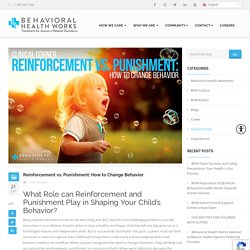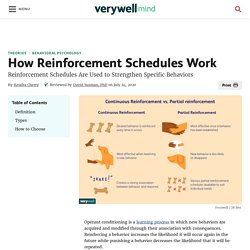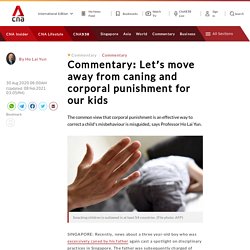Guide for Parents: Reinforcements & Punishments for teenagers
> Xiaoyujia
This is an informative guide on how to influence a teenager's behaviour through the use of Reinforcements and Punishments.
Skinner’s Operant Conditioning: Rewards & Punishments. Reinforcement vs. Punishment: Changing Behavior. Being a parent has been known as the best thing ever BUT also the most challenging endeavor you will encounter in your lifetime.

Parents strive to raise a healthy and happy child that will one day grow up as a full-fledged mature and independent adult. But to successfully accomplish this goal, a parent must set forth structure or rules throughout their childhood to help them understand and be realigned when their behavior needs to be modified. When a parent recognizes the need to change a behavior, they will likely end up using either reinforcement, punishment, or a mixture of both. When we’re helping to decrease the frequency of a child’s negative behavior, having the reinforcement or punishment methods in our toolkit can help you modify and implement the desired behavior.
Positive Reinforcement. Negative Reinforcement.
Examples & Applications of Reinforcements
Continuous Reinforcement. Partial Reinforcement. How Reinforcement Schedules Work. Operant conditioning is a learning process in which new behaviors are acquired and modified through their association with consequences.

Reinforcing a behavior increases the likelihood it will occur again in the future while punishing a behavior decreases the likelihood that it will be repeated. In operant conditioning, schedules of reinforcement are an important component of the learning process.
Positive Punishment. Negative Punishment.
Examples & Applications of Punishments
12 Examples of Positive Punishment & Negative Reinforcement. You might be thinking that “positive punishment” sounds like an oxymoron, after all, how can punishment be positive?

Not many people “like” punishment, right? The disconnect in understanding this concept comes from the usage of the word “positive;” here at PositivePsychology.com, we generally use the term “positive” to refer to things that are inherently good, things that are life-giving, and things that promote thriving and flourishing.
The concept of positive punishment comes from a very different era and a very different perspective on psychology; namely, the 1930s and behaviorism. So, what actually is positive punishment and how does it relate to parenting, teaching, and even the workplace? Before you read on, we thought you might like to download our 3 Positive Psychology Exercises for free. You can download the free PDF here.
Learning: Negative Reinforcement vs. Punishment. Operant Conditioning - Negative Reinforcement vs Positive Punishment.
Reinforcement vs Punishment. Discipline strategies for teenagers. Teenage discipline: the basics Discipline isn’t about punishment.

It’s about teaching children appropriate ways to behave. For teenagers, discipline is about agreeing on and setting appropriate limits and helping them behave within those limits. When your child was younger, you probably used a range of discipline strategies to teach him the basics of good behaviour. Now your child is growing into a teenager, you can use limits and boundaries to help him learn independence, take responsibility for his behaviour and its outcomes, and solve problems. Your child needs these skills to become a young adult with her own standards for appropriate behaviour and respect for others. Teenagers don’t yet have all the skills they need to make all their own decisions, so the limits you agree on for behaviour are an important influence on your child.
Blog Therapy, Therapy, Therapy Blog, Blogging Therapy, Therapy,..
When I work with parents of teenagers, our conversations inevitably turn toward discipline.
“How do get my teen to follow the rules?” “My teen won’t clean up after himself. What should I do?” “Nothing I do seems to have any effect on her!” Discipline with teenagers is complicated. One of the moms at a recent mother-daughter workshop asked me for advice about how to get her daughter to stop being so mean to her little brother. The Difference Between Punishments and Consequences That’s the problem with some favorite go-to punishments—they make the teen suffer for a little while, but they have little impact on changing the behavior.
Punishments are used to impose suffering of some kind and to make it clear who is in control. Consequences, on the other hand, are designed to teach teens to learn from their mistakes. Discipline with teenagers is complicated. How Does That Work in Real Life? So, what does that look like in the real world? Your teen hasn’t been doing chores around the house.
Physical discipline is harmful and ineffective. Let’s move away from caning and corporal punishment for our kids. SINGAPORE: Recently, news about a three year-old boy who was excessively caned by his father again cast a spotlight on disciplinary practices in Singapore.

The father was subsequently charged of ill-treating a child by causing him unnecessary physical pain. Parents who use corporal punishment rarely set out with the intention to injure their children. However, a handful inadvertently cross the line when they are unable to control their emotions and actions. Last year, the Ministry of Social and Family Development investigated 660 cases of physical abuse in Singapore, which accounts for 60 per cent of all child abuse investigations. In a study done by the KK Women’s and Children’s Hospital, the hospital’s emergency room diagnosed 1,971 cases of non-accidental injury in children between 2011 and 2016. READ: Commentary: From COVID-19 to parenthood, judging each other is back with a vengeance READ: When caning of children becomes abuse: Lawyers explain the legal parameters.





